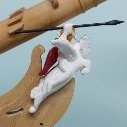MORE HANDBOOKS ARE ON THEIR WAY! We will let you know when they get here.
×
-
Posts
327 -
Joined
-
Last visited
Reputation Activity
-
 Jaxboat got a reaction from AON in deck treenail pattern
Jaxboat got a reaction from AON in deck treenail pattern
Druxey< Interesting factoid about how decks were installed. Any reason planks were trenield and decks spiked?
Best
Jaxboat
-
 Jaxboat got a reaction from mtaylor in How do I clean a filthy 2.5m balsawood battleship.
Jaxboat got a reaction from mtaylor in How do I clean a filthy 2.5m balsawood battleship.
All good ideas. I would start with a medium paint brush and very carefully remove any surface dust I could. The saliva idea is worthwhile. New moms have been using saliva as a primary cleaning agent for their progeny for millennia! . I would also try a dilute solution of Isopropanol. You can buy it at any pharmacy. I would experiment at a discrete can be seen spot on the hull. IPA can affect acrylics but I suspect this model was not painted with acrylics. A weak solution of IPA can remove greasy sol including nicotine. Good luck with he project. It looks like a beautiful model.
Jaxboat
-
 Jaxboat reacted to druxey in MONTAÑES by Amalio
Jaxboat reacted to druxey in MONTAÑES by Amalio
Presumably the plug is in pieces and once a central 'keystone' is extracted the other parts will come out easily - provided nothing has been glued to them!
-
 Jaxboat reacted to dvm27 in MONTAÑES by Amalio
Jaxboat reacted to dvm27 in MONTAÑES by Amalio
His frames are constructed above, below and around the faux-port lids. They are used as templates to help frame the hull. The real question is how will the plug be extracted from the framed hull later on (as seen in the early photos)? The mysterious Amalio will reveal all (hopefully) in his own time.
-
 Jaxboat reacted to druxey in How do I clean a filthy 2.5m balsawood battleship.
Jaxboat reacted to druxey in How do I clean a filthy 2.5m balsawood battleship.
The lightest solvent you can use is saliva. Moisten a Q-tip (cotton bud) and roll it over the surface carefully - don't scrub! It is a long and painstaking process, but should shift the dirt. If it is really greasy, use a dilute soap mix on the cotton buds first, then 'rinse' with saliva and Q-tips. Needless to say, don't put the Q-tip back in your mouth! You will get through a lot of Q-tips and expect to spend serious time on cleaning the model. Good luck with it.
-
 Jaxboat got a reaction from AON in deck treenail pattern
Jaxboat got a reaction from AON in deck treenail pattern
Fascinating! And the amazing thing is there was no "research" as such. Everything was learned through the accumulation of experience over the generations.
Best
Jaxboat
-
 Jaxboat got a reaction from mtaylor in deck treenail pattern
Jaxboat got a reaction from mtaylor in deck treenail pattern
Druxey< Interesting factoid about how decks were installed. Any reason planks were trenield and decks spiked?
Best
Jaxboat
-
 Jaxboat reacted to druxey in deck treenail pattern
Jaxboat reacted to druxey in deck treenail pattern
Treenail end grain would absorb moisture and promote rot.
-
 Jaxboat reacted to druxey in 18th century Deck planking shifts
Jaxboat reacted to druxey in 18th century Deck planking shifts
Certainly there are plans of deck planking in such volumes as the plates in Steel's Naval Architecture. One can see that the outboard strakes are laid either top and butt or anchor stock where the gun carriages run across. Inboard are strakes that are laid either with three or four planks between butts on the same beam. Strakes are also tapered and curve, rather than the modern parallel and joggled style. A few strakes are laid short with a hook instead.
If you are interested, a less expensive volume is the facsimile Rees' Naval Architecture, published in the 1970's. The plates are copied directly from Steel, but at 1:96 scale instead of 1:48. Copies of this useful reference can be found on such sites as abeboooks.com
-
 Jaxboat reacted to druxey in deck treenail pattern
Jaxboat reacted to druxey in deck treenail pattern
The pattern you've drawn looks reasonable. However, a real deck was not treenailed: metal spikes were used and the heads countersunk. The hole above the head was plugged with wood whose grain went the same direction as that of the plank. The result was almost invisible.
-
 Jaxboat got a reaction from dchrismiller in Comparison of Victory kit manufacturers
Jaxboat got a reaction from dchrismiller in Comparison of Victory kit manufacturers
Everyone is waiting for he Amati. Nothing from Chris Watton on it for some time. One big question is will you have a space to display it when finished or will you have to build an addition to your house! I believe Chris also designed the Caldercraft Victory so he would end up with the two best models,
Jaxboat
-
 Jaxboat got a reaction from PeteB in Queen Anne Style Royal Barge by Chuck - FINISHED - Syren Ship Model Company - 1:24
Jaxboat got a reaction from PeteB in Queen Anne Style Royal Barge by Chuck - FINISHED - Syren Ship Model Company - 1:24
Some of you have been subjected to my frequent harping that ship modelers refer to "acrylics" as if it was an all inclusive term, So I found the perfect example today to show it isn't. Many of us use floor polish polymers to provide a removable coating or smooth coating for placing decals. The solution is fairly clear because the acrylic polymers employed are actually water soluble under basic (high pH) conditions because they are low molecular weight and have hydroxyl and acid functional acrylic monomers in them which promote water solubility. Once upon a time, these type of floor polishes also contained a soluble zinc salt which would complex with the functional groups as the polish dried and provide a more durable finish that could only be stripped off using a very basic ammonia solution to resolublize the Zn. The EPA put a stop to that when they realized how much soluble (toxic) Zn was being discharged into rivers and streams. I am only making the point that acrylics vary widely in composition and molecular weight which give them very differing capabilities. It is a very versatile chemistry.
-
 Jaxboat got a reaction from druxey in Queen Anne Style Royal Barge by Chuck - FINISHED - Syren Ship Model Company - 1:24
Jaxboat got a reaction from druxey in Queen Anne Style Royal Barge by Chuck - FINISHED - Syren Ship Model Company - 1:24
Some of you have been subjected to my frequent harping that ship modelers refer to "acrylics" as if it was an all inclusive term, So I found the perfect example today to show it isn't. Many of us use floor polish polymers to provide a removable coating or smooth coating for placing decals. The solution is fairly clear because the acrylic polymers employed are actually water soluble under basic (high pH) conditions because they are low molecular weight and have hydroxyl and acid functional acrylic monomers in them which promote water solubility. Once upon a time, these type of floor polishes also contained a soluble zinc salt which would complex with the functional groups as the polish dried and provide a more durable finish that could only be stripped off using a very basic ammonia solution to resolublize the Zn. The EPA put a stop to that when they realized how much soluble (toxic) Zn was being discharged into rivers and streams. I am only making the point that acrylics vary widely in composition and molecular weight which give them very differing capabilities. It is a very versatile chemistry.
-
 Jaxboat got a reaction from CaptainSteve in Queen Anne Style Royal Barge by Chuck - FINISHED - Syren Ship Model Company - 1:24
Jaxboat got a reaction from CaptainSteve in Queen Anne Style Royal Barge by Chuck - FINISHED - Syren Ship Model Company - 1:24
Some of you have been subjected to my frequent harping that ship modelers refer to "acrylics" as if it was an all inclusive term, So I found the perfect example today to show it isn't. Many of us use floor polish polymers to provide a removable coating or smooth coating for placing decals. The solution is fairly clear because the acrylic polymers employed are actually water soluble under basic (high pH) conditions because they are low molecular weight and have hydroxyl and acid functional acrylic monomers in them which promote water solubility. Once upon a time, these type of floor polishes also contained a soluble zinc salt which would complex with the functional groups as the polish dried and provide a more durable finish that could only be stripped off using a very basic ammonia solution to resolublize the Zn. The EPA put a stop to that when they realized how much soluble (toxic) Zn was being discharged into rivers and streams. I am only making the point that acrylics vary widely in composition and molecular weight which give them very differing capabilities. It is a very versatile chemistry.
-
 Jaxboat got a reaction from grsjax in Queen Anne Style Royal Barge by Chuck - FINISHED - Syren Ship Model Company - 1:24
Jaxboat got a reaction from grsjax in Queen Anne Style Royal Barge by Chuck - FINISHED - Syren Ship Model Company - 1:24
Some of you have been subjected to my frequent harping that ship modelers refer to "acrylics" as if it was an all inclusive term, So I found the perfect example today to show it isn't. Many of us use floor polish polymers to provide a removable coating or smooth coating for placing decals. The solution is fairly clear because the acrylic polymers employed are actually water soluble under basic (high pH) conditions because they are low molecular weight and have hydroxyl and acid functional acrylic monomers in them which promote water solubility. Once upon a time, these type of floor polishes also contained a soluble zinc salt which would complex with the functional groups as the polish dried and provide a more durable finish that could only be stripped off using a very basic ammonia solution to resolublize the Zn. The EPA put a stop to that when they realized how much soluble (toxic) Zn was being discharged into rivers and streams. I am only making the point that acrylics vary widely in composition and molecular weight which give them very differing capabilities. It is a very versatile chemistry.
-
 Jaxboat got a reaction from PeteB in Queen Anne Style Royal Barge by Chuck - FINISHED - Syren Ship Model Company - 1:24
Jaxboat got a reaction from PeteB in Queen Anne Style Royal Barge by Chuck - FINISHED - Syren Ship Model Company - 1:24
You are correct, Druxey. The energy imparted by the brushing or spraying breaks the temporary hydrogen bonds that form when no energy is being applied. When the energy is no longer being applied the hydrogen bonds reform and give a higher apparent viscosity
Best
Jaxboat
-
 Jaxboat got a reaction from PeteB in Queen Anne Style Royal Barge by Chuck - FINISHED - Syren Ship Model Company - 1:24
Jaxboat got a reaction from PeteB in Queen Anne Style Royal Barge by Chuck - FINISHED - Syren Ship Model Company - 1:24
Love the discussion on paint. Grumbacher was once my customer for acrylic vehicles in the early seventies. I sold them 55 gal drums of the same acrylic vehicle as I was selling to clients making exterior house paint. One must remember that acrylic paint is not a all inclusive monolithic term like alkyd paint . "Acrylic" is a type of chemistry . In the water borne paint area a it encompasses everything from 100% emulsions (i.e. no water solubility at all) to partially solubilized vehicles. Additives also have a huge impact on rheology and flow. Frequent applications with water reduced (or alcohol reduced) solids will result in excellent flow and leveling but if you dilute too much you will have problems.
I was very interested in your comments on brushes. I am well aware of Druxey's preferences. Most acrylic vehicles give non-Newtonian flow and are thixotropic. The brush not only puts paint on the surface but the act of brushing generates energy which results in improved flow. In essence the energy applied breaks down bonds temporally which results in a temporary reduction in viscosity which allows for improved flow and leveling. Not sure why a flat brush would give you differing results but it is an interesting question.
-
 Jaxboat got a reaction from druxey in Queen Anne Style Royal Barge by Chuck - FINISHED - Syren Ship Model Company - 1:24
Jaxboat got a reaction from druxey in Queen Anne Style Royal Barge by Chuck - FINISHED - Syren Ship Model Company - 1:24
You are correct, Druxey. The energy imparted by the brushing or spraying breaks the temporary hydrogen bonds that form when no energy is being applied. When the energy is no longer being applied the hydrogen bonds reform and give a higher apparent viscosity
Best
Jaxboat
-
 Jaxboat got a reaction from CaptainSteve in Queen Anne Style Royal Barge by Chuck - FINISHED - Syren Ship Model Company - 1:24
Jaxboat got a reaction from CaptainSteve in Queen Anne Style Royal Barge by Chuck - FINISHED - Syren Ship Model Company - 1:24
Love the discussion on paint. Grumbacher was once my customer for acrylic vehicles in the early seventies. I sold them 55 gal drums of the same acrylic vehicle as I was selling to clients making exterior house paint. One must remember that acrylic paint is not a all inclusive monolithic term like alkyd paint . "Acrylic" is a type of chemistry . In the water borne paint area a it encompasses everything from 100% emulsions (i.e. no water solubility at all) to partially solubilized vehicles. Additives also have a huge impact on rheology and flow. Frequent applications with water reduced (or alcohol reduced) solids will result in excellent flow and leveling but if you dilute too much you will have problems.
I was very interested in your comments on brushes. I am well aware of Druxey's preferences. Most acrylic vehicles give non-Newtonian flow and are thixotropic. The brush not only puts paint on the surface but the act of brushing generates energy which results in improved flow. In essence the energy applied breaks down bonds temporally which results in a temporary reduction in viscosity which allows for improved flow and leveling. Not sure why a flat brush would give you differing results but it is an interesting question.
-
 Jaxboat got a reaction from CaptainSteve in Queen Anne Style Royal Barge by Chuck - FINISHED - Syren Ship Model Company - 1:24
Jaxboat got a reaction from CaptainSteve in Queen Anne Style Royal Barge by Chuck - FINISHED - Syren Ship Model Company - 1:24
You are correct, Druxey. The energy imparted by the brushing or spraying breaks the temporary hydrogen bonds that form when no energy is being applied. When the energy is no longer being applied the hydrogen bonds reform and give a higher apparent viscosity
Best
Jaxboat
-
 Jaxboat reacted to druxey in Queen Anne Style Royal Barge by Chuck - FINISHED - Syren Ship Model Company - 1:24
Jaxboat reacted to druxey in Queen Anne Style Royal Barge by Chuck - FINISHED - Syren Ship Model Company - 1:24
Thanks, Allan. I understood the term thixotropic, but wondered why energy imparted by brush action temporarily caused easier flow. I imagine it is something at the molecular bond level, but what? Enquiring minds....
-
 Jaxboat reacted to druxey in Queen Anne Style Royal Barge by Chuck - FINISHED - Syren Ship Model Company - 1:24
Jaxboat reacted to druxey in Queen Anne Style Royal Barge by Chuck - FINISHED - Syren Ship Model Company - 1:24
Your comments on paint flow are interesting Jaxboat. Can you explain why the energy imparted from the brush converts into better flow characteristics?
-
 Jaxboat reacted to allanyed in Queen Anne Style Royal Barge by Chuck - FINISHED - Syren Ship Model Company - 1:24
Jaxboat reacted to allanyed in Queen Anne Style Royal Barge by Chuck - FINISHED - Syren Ship Model Company - 1:24
Druxey,
Sorry to jump in on Jaxboats detailed explanation. My understanding from WAYYYY back when I worked in the paint industry, the paint referenced above is thixatropic. If it is agitated, sheared or otherwise stressed, the viscosity drops temporarily. It will thicken up again when at rest and of course it will dry if left exposed to air so the vehicle (water and other solvents) evaporate. The brush is shearing the paint which is causing it the thin, thus flows more readily. This is a rather basic explanation, I am sure there is a lot more detail that can explain how and why the physical properties change temporarily. I THINK some or perhaps most modeling clays are thixatropic. As they are kneaded they are more easily worked, at least in my experience.
Allan
-
 Jaxboat got a reaction from WackoWolf in Queen Anne Style Royal Barge by Chuck - FINISHED - Syren Ship Model Company - 1:24
Jaxboat got a reaction from WackoWolf in Queen Anne Style Royal Barge by Chuck - FINISHED - Syren Ship Model Company - 1:24
Love the discussion on paint. Grumbacher was once my customer for acrylic vehicles in the early seventies. I sold them 55 gal drums of the same acrylic vehicle as I was selling to clients making exterior house paint. One must remember that acrylic paint is not a all inclusive monolithic term like alkyd paint . "Acrylic" is a type of chemistry . In the water borne paint area a it encompasses everything from 100% emulsions (i.e. no water solubility at all) to partially solubilized vehicles. Additives also have a huge impact on rheology and flow. Frequent applications with water reduced (or alcohol reduced) solids will result in excellent flow and leveling but if you dilute too much you will have problems.
I was very interested in your comments on brushes. I am well aware of Druxey's preferences. Most acrylic vehicles give non-Newtonian flow and are thixotropic. The brush not only puts paint on the surface but the act of brushing generates energy which results in improved flow. In essence the energy applied breaks down bonds temporally which results in a temporary reduction in viscosity which allows for improved flow and leveling. Not sure why a flat brush would give you differing results but it is an interesting question.
-
 Jaxboat got a reaction from donfarr in Queen Anne Style Royal Barge by Chuck - FINISHED - Syren Ship Model Company - 1:24
Jaxboat got a reaction from donfarr in Queen Anne Style Royal Barge by Chuck - FINISHED - Syren Ship Model Company - 1:24
Love the discussion on paint. Grumbacher was once my customer for acrylic vehicles in the early seventies. I sold them 55 gal drums of the same acrylic vehicle as I was selling to clients making exterior house paint. One must remember that acrylic paint is not a all inclusive monolithic term like alkyd paint . "Acrylic" is a type of chemistry . In the water borne paint area a it encompasses everything from 100% emulsions (i.e. no water solubility at all) to partially solubilized vehicles. Additives also have a huge impact on rheology and flow. Frequent applications with water reduced (or alcohol reduced) solids will result in excellent flow and leveling but if you dilute too much you will have problems.
I was very interested in your comments on brushes. I am well aware of Druxey's preferences. Most acrylic vehicles give non-Newtonian flow and are thixotropic. The brush not only puts paint on the surface but the act of brushing generates energy which results in improved flow. In essence the energy applied breaks down bonds temporally which results in a temporary reduction in viscosity which allows for improved flow and leveling. Not sure why a flat brush would give you differing results but it is an interesting question.









